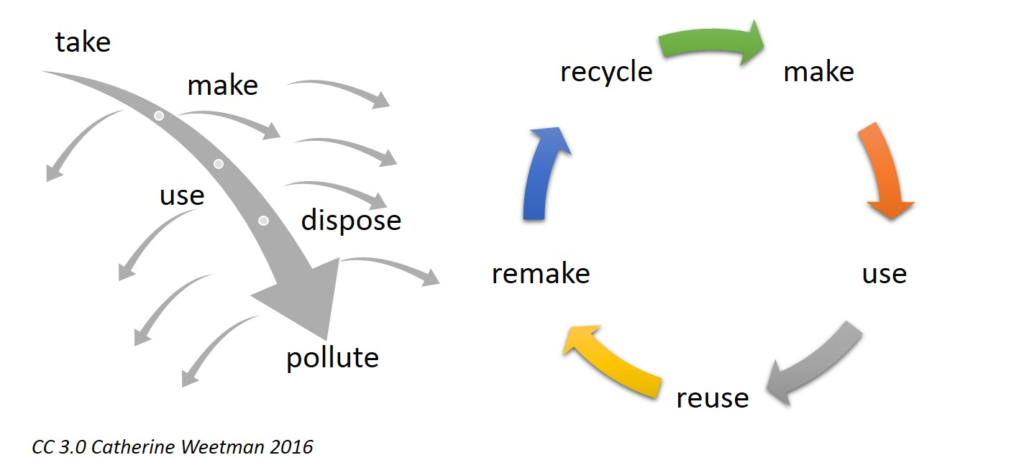If you’re like me – torn about whether the whole circular economy fuzz is a good thing or not, especially for the long haul, please read my critical analysis below.
The concept of circular economy (CE) is grounded in environmental and ecological economics, industrial ecology theory, and general systems theory. CE origins are often attributed to ecological economists Pearce and Turner who, based on Boulding’s metaphor of the Earth as a “spaceship” (a closed system), developed a theoretical framework describing the shift from an open-ended economic system to a circular one due to constraints imposed by the laws of thermodynamics. CE is a response to the need to manage the ever-increasing waste generated within the “take-make-dispose” model of the predominantly linear economy.

CE builds upon the perception of a city as an ecosystem and can be defined as “a regenerative system in which resource input and waste, emission, and energy leakage are minimized by slowing, closing, and narrowing material and energy loops. This can be achieved through long-lasting design, maintenance, repair, reuse, remanufacturing, refurbishing, and recycling”. In earlier iterations CE, informed by weak sustainability theory, was seen as a new business model for sustainability associated with “greener” industrial processes – a model still found in corporate CE initiatives. CE theory and practice are today increasingly influenced by SS approaches such as cradle-to-cradle, regenerative design, and biomimicry.
In Europe, China, and elsewhere, the CE is promoted as a step toward “the ultimate goal of decoupling economic growth from resource consumption”. In some places, a relative, localized, or temporary decoupling has been achieved through efficiencies and agendas such as eco-cities, but the true ultimate goal that prevails globally is that of economic growth.CE can contribute to a degrowth path, but not to complete decoupling since recycling and circularity are limited by thermodynamics.
The literature views CE in three broad ways: as a condition for sustainability, a beneficial relation, or a trade-off. Like sustainability, CE advocates for interdisciplinary research, multi-stakeholder cooperation, and exploration of multiple pathways and benefits of development. However, long-term approaches and integration of social concerns and well-being objectives are only sporadically encountered in CE so far. By focusing on economic, financial, and resource optimization goals and immediate results, corporate or government decision-makers may be missing opportunities to funnel resources to address all three sustainability pillars and promote deeper change.
On the upside, compared to sustainability, CE is better defined and has clear directions in terms of implementation potential. It appeals to policy-makers and private actors more than the (flexible but vague) concept of sustainability. Fortunately CE initiatives are already shifting this focus from quantitative growth toward qualitative and regenerative development and are well positioned to help achieve sustainability.
Bibliography
Geissdoerfer, M., Savaget, P., Bocken, N. M. P., & Hultink, E. J. (2017). The Circular Economy – A new sustainability paradigm? Journal of Cleaner Production,143, 757–768. https://doi.org/10.1016/j.jclepro.2016.12.048
Ghisellini, P., Cialani, C., & Ulgiati, S. (2014). A review on circular economy: The expected transition to a balanced interplay of environmental and economic systems. .Journal of Cleaner Production,114, 11–32. https://doi.org/10.1016/j.jclepro.2015.09.007
Girardet, H. (2015). Creating Regenerative Cities. Routledge.
Korhonen, J., Honkasalo, A., & Seppälä, J. (2018). Circular Economy: The Concept and its Limitations. Ecological Economics,143, 37–46. https://doi.org/10.1016/j.ecolecon.2017.06.041
McDonough, W., & Braungart, M. (2013). The upcycle: Beyond sustainability – Designing for abundance. North Point Press, a division of Farrar, Straus and Giroux. https://doi.org/10.1108/ijshe.2013.24914daa.010
Newman, P., & Jennings, I. (2008). Cities as sustainable ecosystems: Principles and practices. Island Press.

















